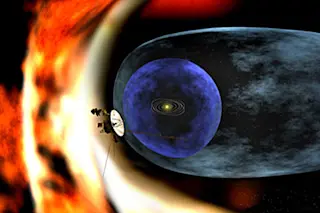Nobody expected to take it this far. When NASA launched two probes named Voyager 1 and Voyager 2 in the summer of 1977, scientists hoped the probes would get as far as Saturn during their five-year mission. Instead, the nuclear-powered explorers are still sending data home over 30 years after their launch, and are currently pushing through the boundary of our solar system into interstellar space. A collection of five papers in tomorrow's issue of the journal Nature [subscription required] analyze the data sent back from Voyager 2 as it reached
a turbulent frontier known as the termination shock. The sun is constantly spewing out particles in all directions; as these particles move through the solar system, they are known as the solar wind. This wind pushes back against the interstellar plasma that exists throughout the galaxy. At the end of the solar system, the solar wind finally begins to ...














